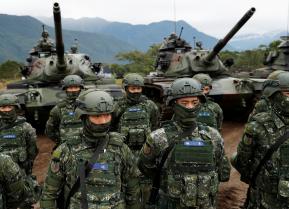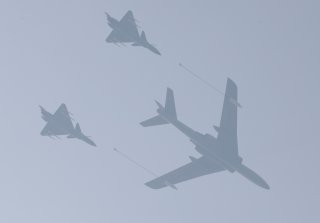What’s Behind China’s Growing Military Activity Around Taiwan?
A worrying spike in Chinese military activity near Taiwan since the beginning of 2020 has led some analysts to conclude that Beijing is exploiting a moment of distraction within the international system due to the COVID-19 pandemic to intimidate Taiwan and create a fait accompli in the Taiwan Strait. Closer analysis of trends that predate the outbreak, however, suggests that Beijing would have adopted the same escalatory strategy regardless of the international situation.
At this point, Beijing had concluded that the twin policies of “goodwill” and “punishment” had failed. Taiwanese society was slipping away. Its frustrations took shape during the National People’s Congress in May 2020, when, for the first time, the term “peaceful” was removed from the regime’s talk on unification. Much ink has been spilled since then analyzing the meaning and ramifications of this rhetorical elision. Suffice it to say that the decision to leave “peaceful” unmentioned had more to do with domestic consumption than with the Taiwanese, who have known all along that “peaceful unification” was little more than a reassuring euphemism for a hostile takeover.
Stuck in a corner of its own making after years of cultivating ultranationalism among the Chinese, Xi’s CCP had little choice but to demonstrate that it was doing something about Taiwan. It could not admit that the past decade had been one of utter, unmitigated failure in Beijing’s cross-Strait policy. The Taiwanese public was slipping away (though state media in China still could not admit so, preferring instead to refer to groups of “separatists” and their “foreign allies”), but one thing wasn’t: Taiwan’s real estate. Thus, all else having failed, Taiwan would have to be subjected to a greater dose of military coercion — in fact, starting in 2019 some hawkish military strategists within the PLA, people like Wang Hongguang, were already admitting that “peaceful unification” was no longer an option and that force would be necessary to “retake” Taiwan. Consequently, it is seven years of a failed cross-Strait policy under Xi, rather than COVID-19, which helps explain why PLA activity around Taiwan has become more assertive, and frequent, in recent months. Tsai’s re-election, above all, constituted the green light.
Another factor that could help explain the intensification of Chinese military activity around Taiwan and within the region — including along the border with India, where clashes have occurred recently — is the situation within China. Given the nature of the regime and the incessant clampdown on free expression, it is difficult to determine how the Chinese economy and its society were affected by the COVID-19 outbreak, which is believed to have originated in Wuhan. For the first time in decades, the Chinese government has decided not to release projections for GDP growth this year, and there are signs that an already fragile economic recovery is encountering new headwinds. Notwithstanding assurances that Beijing handled the outbreak with brio and a global propaganda campaign to that effect, it is quite possible that Mr. Xi’s image, along with that of the CCP, has been damaged by its early response to the outbreak. Just how much is difficult to quantify. A deepening trade war with the U.S., which is turning increasingly into an ideological war as well, has also sparked accusations of mishandling, and a number of voices, Committee of the Chinese People’s Political Consultative Conference (CPPCC) Chairman Wang Yang reportedly among them, voiced opposition to Xi’s imposition of a new national security law in crisis-prone Hong Kong. Having installed himself as president for life, Mr. Xi’s insecurities may be coming to the surface: amid chatter that some enemies of Xi within the CCP may seek to oust him by 2022, when, in theory, his second term would have ended, the Chinese leader has been busy eliminating more of his potential opponents within the party while appointing his close allies to key positions.
Thus, while it is impossible to fathom the extent to which Xi may feel embattled, it is nevertheless within the realm of reasonable speculation to posit that a more tenuous position domestically might tempt the Chinese leader to consolidate his position by tapping into nationalist sentiment. And that, above all, invites externalization — conflict abroad, and the cultivation of a sentiment of injustice at the hands of external foes. In this context, Taiwan provides a highly potent emotional distraction, especially as its 23.8 million people have, in the Chinese view, been unacceptably rude in their refusal to embrace China by subjecting to its unification dreams.
Despite internal tensions and a highly charged ideological environment, there is little reason to believe that the Chinese leadership is acting irrationally. So far, and unless the domestic situation threatens the very survival of the CCP, the Chinese regime has calculated along rational lines and refrained from taking actions which could spark major retaliation by the U.S. and other powers. It therefore appears to remain committed to a policy of gradualism, or “salami slicing,” within its sphere of influence, and thus is unlikely to behave in a highly provocative manner. Cool heads still prevail within the PLA and the CCP, where there is general agreement that China still doesn’t have sufficient military capability to take on the world’s No. 1 superpower. There is an ongoing debate on the matter, and arguments for both sides have appeared in the pages of state-controlled media, but given the extreme risks of confrontation, the CCP can be expected to continue to edge on the side of caution for the next few years,
What this means for its future behavior toward Taiwan, therefore, is that rhetoric and military maneuvers are primarily intended to act as instruments of psychological warfare against its people and leadership. The likelihood that Beijing would call upon the PLA to launch a major amphibious assault to seize and pacify Taiwan — according to many specialists, under conditions that would make such un undertaking the most onerous in military history — therefore remains relatively low, and should continue to do so as long as the (a) Taiwan presents a credible deterrent; (b) the U.S. continues to provide security guarantees to Taiwan; and (c) the PLA leadership remains unconvinced that his has the capabilities and experience to embark on such an adventure. Given the likelihood of escalation, there is also a low probability that China would attempt to invade Taiwan’s main outlying islands of Kinmen and Matsu. A likelier scenario is one in which the PLA would invade and gain control over islets controlled by Taiwan in the South China Sea. Already, state media have announced that the PLA will conduct exercises in the area in August simulating an assault on such features, with some reports claiming that the simulation to turn into the real thing (other analysts argue that the islets have lost their geostrategic importance after China has built eight artificial islands in the area). Militarily speaking, seizing islets controlled Taiwan in the Pratas or Spratlys would not be too difficult or costly a task, and while destabilizing, it is equally unlikely that Taiwan, the U.S., or other regional claimants would risk major armed conflict with China for their protection (lines of communication between Taiwan’s southernmost tip and its assets in the South China Sea are of such length as to make the islets practically indefensible against sustained attack).
Still, seizing an islet under Taiwan’s jurisdiction would provide the Chinese leadership with a much-needed gain, while conferring upon the PLA further strategic depth. There would also be a political component to such action, as this would embolden opponents of the Tsai administration in their accusations that her policies are resulting in an erosion of the ROC’s territory. The effects of such an outcome would be rather limited, however, as the great majority of Taiwanese have little if any sense of attachment toward islets in the South China Sea, and certainly would not be in favor of risking the lives of their young men and women defending them.
While Taiwan must continue to develop its deterrent capability, on its own and in conjunction with allies within the region, so as to preclude the possibility of Beijing calculating that it can get away with a quick invasion, for the foreseeable future more limited military scenarios — intrusions, provocations, harassment and the seizing of distant islets under Taiwan’s jurisdiction — remain the likeliest. Nevertheless, given the higher density of multinational military traffic in the Taiwan Strait and around the island-nation, the possibility of accidents and inadvertent clashes will increase commensurately, and with that the dangers of quick escalation due, in large part, to the ultranationalism that currently is at boiling point in China, which would make de-escalation by the CCP all the more difficult.
J. Michael Cole is a Taipei-based senior fellow with the Global Taiwan Institute in Washington, D.C., the Macdonald-Laurier Institute in Ottawa and the Taiwan Studies Programme at the University of Nottingham, U.K. His latest book, Cross-Strait Relations Since 2016: The End of the Illusion, was published by Routledge in March.


